University Report: Managing Across Borders and Internationalization
VerifiedAdded on 2020/03/02
|16
|3927
|196
Report
AI Summary
This report provides a comprehensive analysis of managing across borders and the process of internationalization. It begins with an executive summary highlighting the challenges and opportunities present in the global environment, emphasizing the importance of understanding cultural barriers and preparing employees for cross-border interactions. The report explores cross-cultural issues, offering insights based on Hofstede's cultural dimensions theory and suggesting strategies for effective communication and intercultural competence. It then delves into organizational business strategies for market penetration, discussing market entry plans, PEST analysis, joint ventures, and franchising. The report also addresses strategic human resource practices, the impact of technology, and the importance of adapting to competition. The conclusion emphasizes the need for a holistic approach to global management that considers both the strengths and weaknesses of international management practices, along with the importance of ethical business practices and risk management. The report highlights the significance of market research, the BCG and McKinsey matrices, and the VRIO framework in understanding the market and achieving competitive advantage.
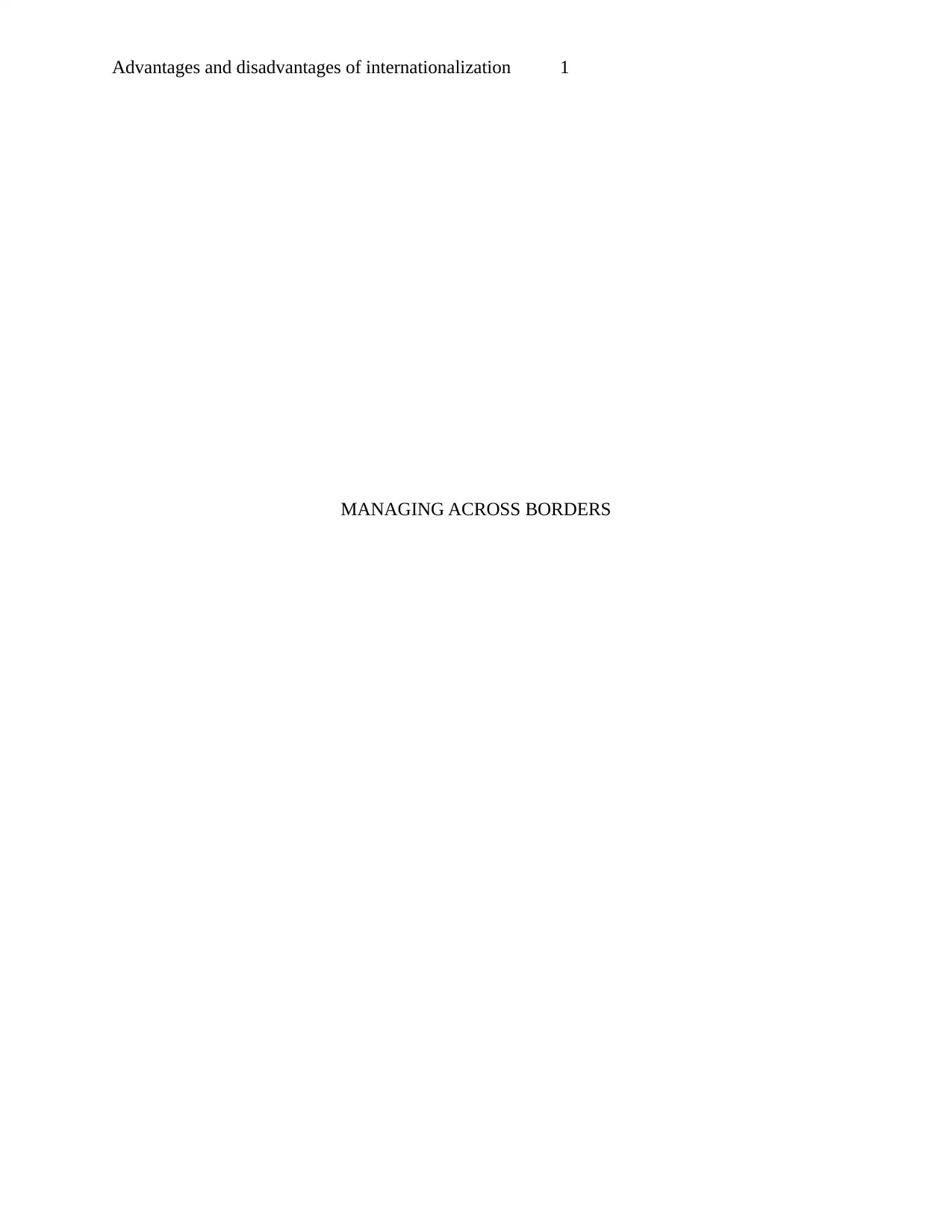
Advantages and disadvantages of internationalization 1
MANAGING ACROSS BORDERS
MANAGING ACROSS BORDERS
Paraphrase This Document
Need a fresh take? Get an instant paraphrase of this document with our AI Paraphraser
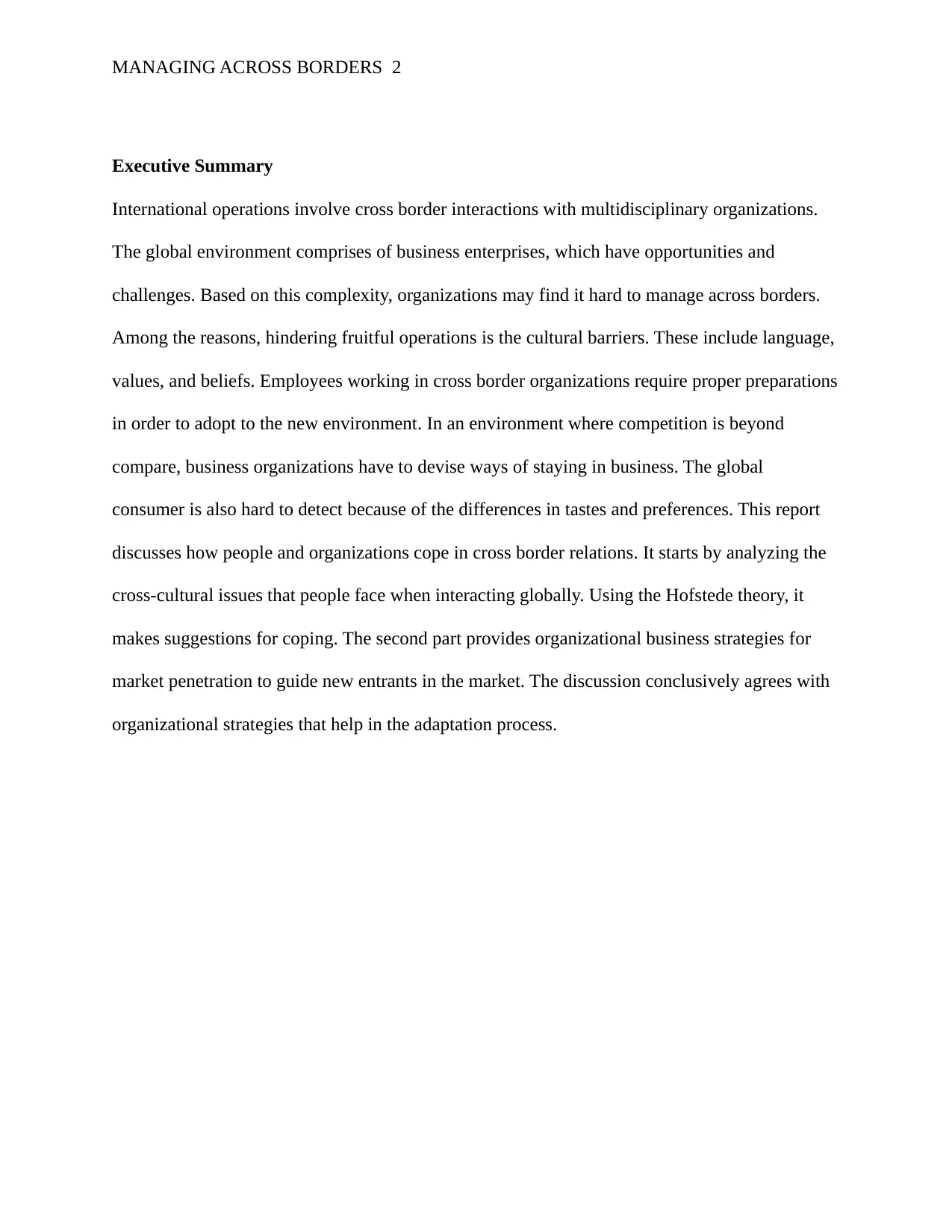
MANAGING ACROSS BORDERS 2
Executive Summary
International operations involve cross border interactions with multidisciplinary organizations.
The global environment comprises of business enterprises, which have opportunities and
challenges. Based on this complexity, organizations may find it hard to manage across borders.
Among the reasons, hindering fruitful operations is the cultural barriers. These include language,
values, and beliefs. Employees working in cross border organizations require proper preparations
in order to adopt to the new environment. In an environment where competition is beyond
compare, business organizations have to devise ways of staying in business. The global
consumer is also hard to detect because of the differences in tastes and preferences. This report
discusses how people and organizations cope in cross border relations. It starts by analyzing the
cross-cultural issues that people face when interacting globally. Using the Hofstede theory, it
makes suggestions for coping. The second part provides organizational business strategies for
market penetration to guide new entrants in the market. The discussion conclusively agrees with
organizational strategies that help in the adaptation process.
Executive Summary
International operations involve cross border interactions with multidisciplinary organizations.
The global environment comprises of business enterprises, which have opportunities and
challenges. Based on this complexity, organizations may find it hard to manage across borders.
Among the reasons, hindering fruitful operations is the cultural barriers. These include language,
values, and beliefs. Employees working in cross border organizations require proper preparations
in order to adopt to the new environment. In an environment where competition is beyond
compare, business organizations have to devise ways of staying in business. The global
consumer is also hard to detect because of the differences in tastes and preferences. This report
discusses how people and organizations cope in cross border relations. It starts by analyzing the
cross-cultural issues that people face when interacting globally. Using the Hofstede theory, it
makes suggestions for coping. The second part provides organizational business strategies for
market penetration to guide new entrants in the market. The discussion conclusively agrees with
organizational strategies that help in the adaptation process.
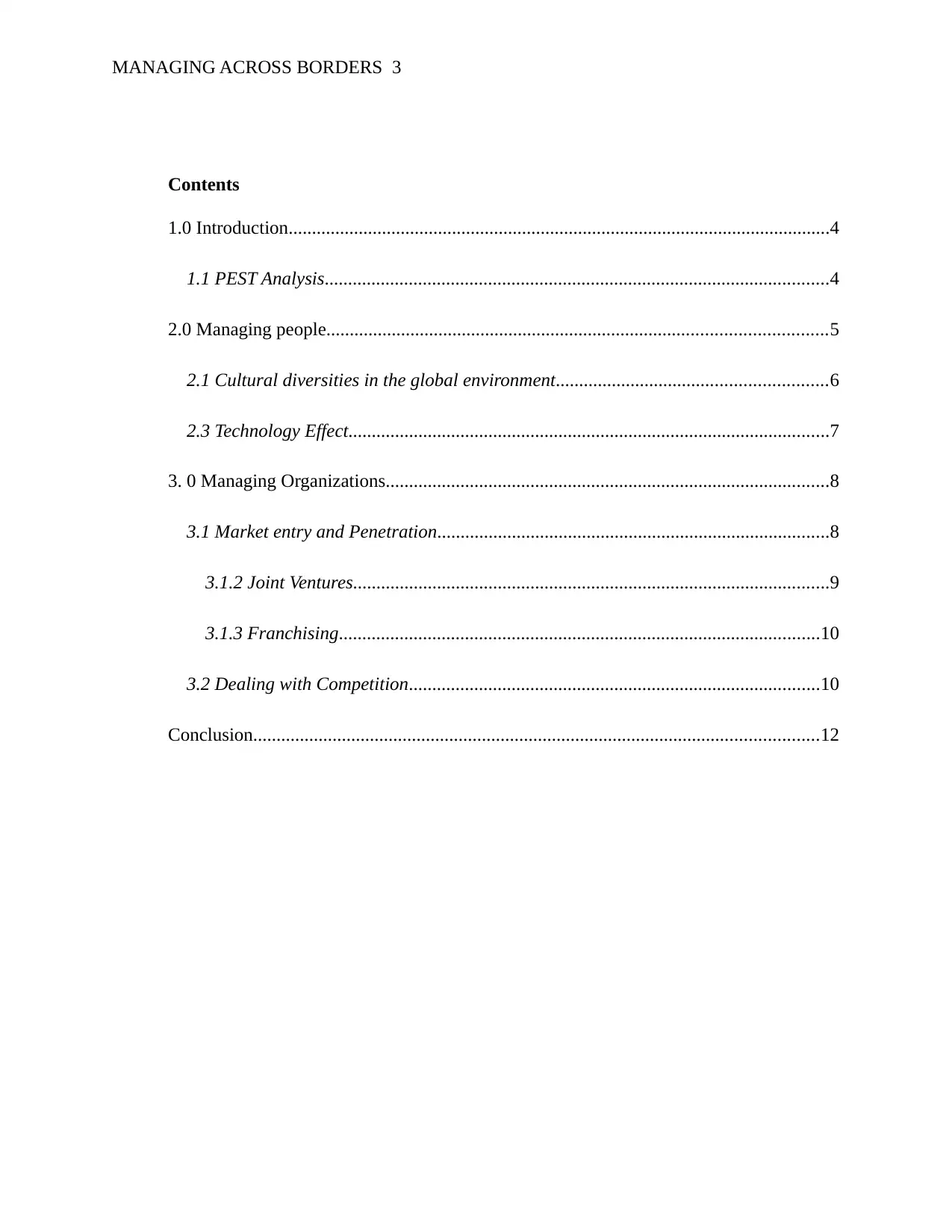
MANAGING ACROSS BORDERS 3
Contents
1.0 Introduction....................................................................................................................4
1.1 PEST Analysis............................................................................................................4
2.0 Managing people...........................................................................................................5
2.1 Cultural diversities in the global environment..........................................................6
2.3 Technology Effect.......................................................................................................7
3. 0 Managing Organizations...............................................................................................8
3.1 Market entry and Penetration....................................................................................8
3.1.2 Joint Ventures......................................................................................................9
3.1.3 Franchising.......................................................................................................10
3.2 Dealing with Competition........................................................................................10
Conclusion.........................................................................................................................12
Contents
1.0 Introduction....................................................................................................................4
1.1 PEST Analysis............................................................................................................4
2.0 Managing people...........................................................................................................5
2.1 Cultural diversities in the global environment..........................................................6
2.3 Technology Effect.......................................................................................................7
3. 0 Managing Organizations...............................................................................................8
3.1 Market entry and Penetration....................................................................................8
3.1.2 Joint Ventures......................................................................................................9
3.1.3 Franchising.......................................................................................................10
3.2 Dealing with Competition........................................................................................10
Conclusion.........................................................................................................................12
⊘ This is a preview!⊘
Do you want full access?
Subscribe today to unlock all pages.

Trusted by 1+ million students worldwide
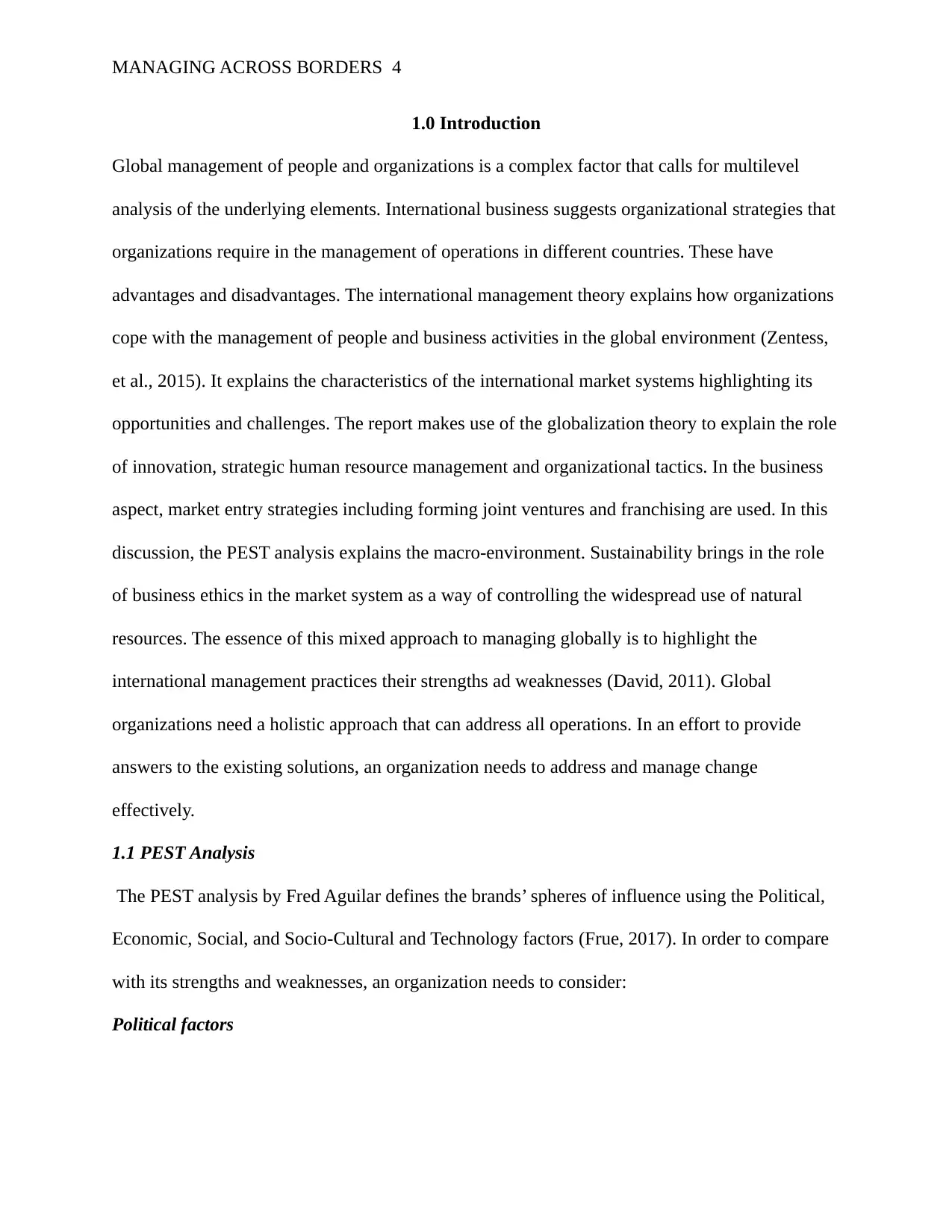
MANAGING ACROSS BORDERS 4
1.0 Introduction
Global management of people and organizations is a complex factor that calls for multilevel
analysis of the underlying elements. International business suggests organizational strategies that
organizations require in the management of operations in different countries. These have
advantages and disadvantages. The international management theory explains how organizations
cope with the management of people and business activities in the global environment (Zentess,
et al., 2015). It explains the characteristics of the international market systems highlighting its
opportunities and challenges. The report makes use of the globalization theory to explain the role
of innovation, strategic human resource management and organizational tactics. In the business
aspect, market entry strategies including forming joint ventures and franchising are used. In this
discussion, the PEST analysis explains the macro-environment. Sustainability brings in the role
of business ethics in the market system as a way of controlling the widespread use of natural
resources. The essence of this mixed approach to managing globally is to highlight the
international management practices their strengths ad weaknesses (David, 2011). Global
organizations need a holistic approach that can address all operations. In an effort to provide
answers to the existing solutions, an organization needs to address and manage change
effectively.
1.1 PEST Analysis
The PEST analysis by Fred Aguilar defines the brands’ spheres of influence using the Political,
Economic, Social, and Socio-Cultural and Technology factors (Frue, 2017). In order to compare
with its strengths and weaknesses, an organization needs to consider:
Political factors
1.0 Introduction
Global management of people and organizations is a complex factor that calls for multilevel
analysis of the underlying elements. International business suggests organizational strategies that
organizations require in the management of operations in different countries. These have
advantages and disadvantages. The international management theory explains how organizations
cope with the management of people and business activities in the global environment (Zentess,
et al., 2015). It explains the characteristics of the international market systems highlighting its
opportunities and challenges. The report makes use of the globalization theory to explain the role
of innovation, strategic human resource management and organizational tactics. In the business
aspect, market entry strategies including forming joint ventures and franchising are used. In this
discussion, the PEST analysis explains the macro-environment. Sustainability brings in the role
of business ethics in the market system as a way of controlling the widespread use of natural
resources. The essence of this mixed approach to managing globally is to highlight the
international management practices their strengths ad weaknesses (David, 2011). Global
organizations need a holistic approach that can address all operations. In an effort to provide
answers to the existing solutions, an organization needs to address and manage change
effectively.
1.1 PEST Analysis
The PEST analysis by Fred Aguilar defines the brands’ spheres of influence using the Political,
Economic, Social, and Socio-Cultural and Technology factors (Frue, 2017). In order to compare
with its strengths and weaknesses, an organization needs to consider:
Political factors
Paraphrase This Document
Need a fresh take? Get an instant paraphrase of this document with our AI Paraphraser
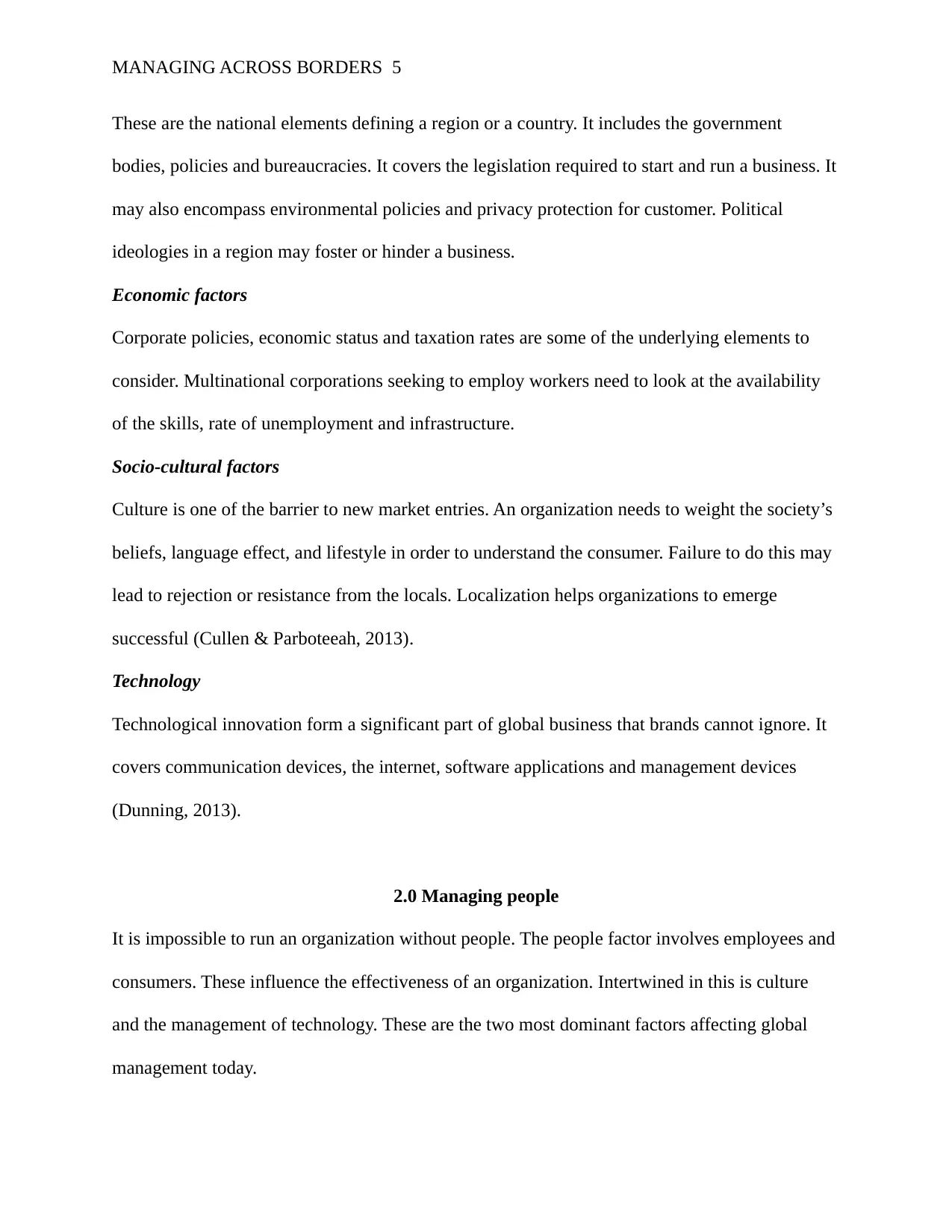
MANAGING ACROSS BORDERS 5
These are the national elements defining a region or a country. It includes the government
bodies, policies and bureaucracies. It covers the legislation required to start and run a business. It
may also encompass environmental policies and privacy protection for customer. Political
ideologies in a region may foster or hinder a business.
Economic factors
Corporate policies, economic status and taxation rates are some of the underlying elements to
consider. Multinational corporations seeking to employ workers need to look at the availability
of the skills, rate of unemployment and infrastructure.
Socio-cultural factors
Culture is one of the barrier to new market entries. An organization needs to weight the society’s
beliefs, language effect, and lifestyle in order to understand the consumer. Failure to do this may
lead to rejection or resistance from the locals. Localization helps organizations to emerge
successful (Cullen & Parboteeah, 2013).
Technology
Technological innovation form a significant part of global business that brands cannot ignore. It
covers communication devices, the internet, software applications and management devices
(Dunning, 2013).
2.0 Managing people
It is impossible to run an organization without people. The people factor involves employees and
consumers. These influence the effectiveness of an organization. Intertwined in this is culture
and the management of technology. These are the two most dominant factors affecting global
management today.
These are the national elements defining a region or a country. It includes the government
bodies, policies and bureaucracies. It covers the legislation required to start and run a business. It
may also encompass environmental policies and privacy protection for customer. Political
ideologies in a region may foster or hinder a business.
Economic factors
Corporate policies, economic status and taxation rates are some of the underlying elements to
consider. Multinational corporations seeking to employ workers need to look at the availability
of the skills, rate of unemployment and infrastructure.
Socio-cultural factors
Culture is one of the barrier to new market entries. An organization needs to weight the society’s
beliefs, language effect, and lifestyle in order to understand the consumer. Failure to do this may
lead to rejection or resistance from the locals. Localization helps organizations to emerge
successful (Cullen & Parboteeah, 2013).
Technology
Technological innovation form a significant part of global business that brands cannot ignore. It
covers communication devices, the internet, software applications and management devices
(Dunning, 2013).
2.0 Managing people
It is impossible to run an organization without people. The people factor involves employees and
consumers. These influence the effectiveness of an organization. Intertwined in this is culture
and the management of technology. These are the two most dominant factors affecting global
management today.
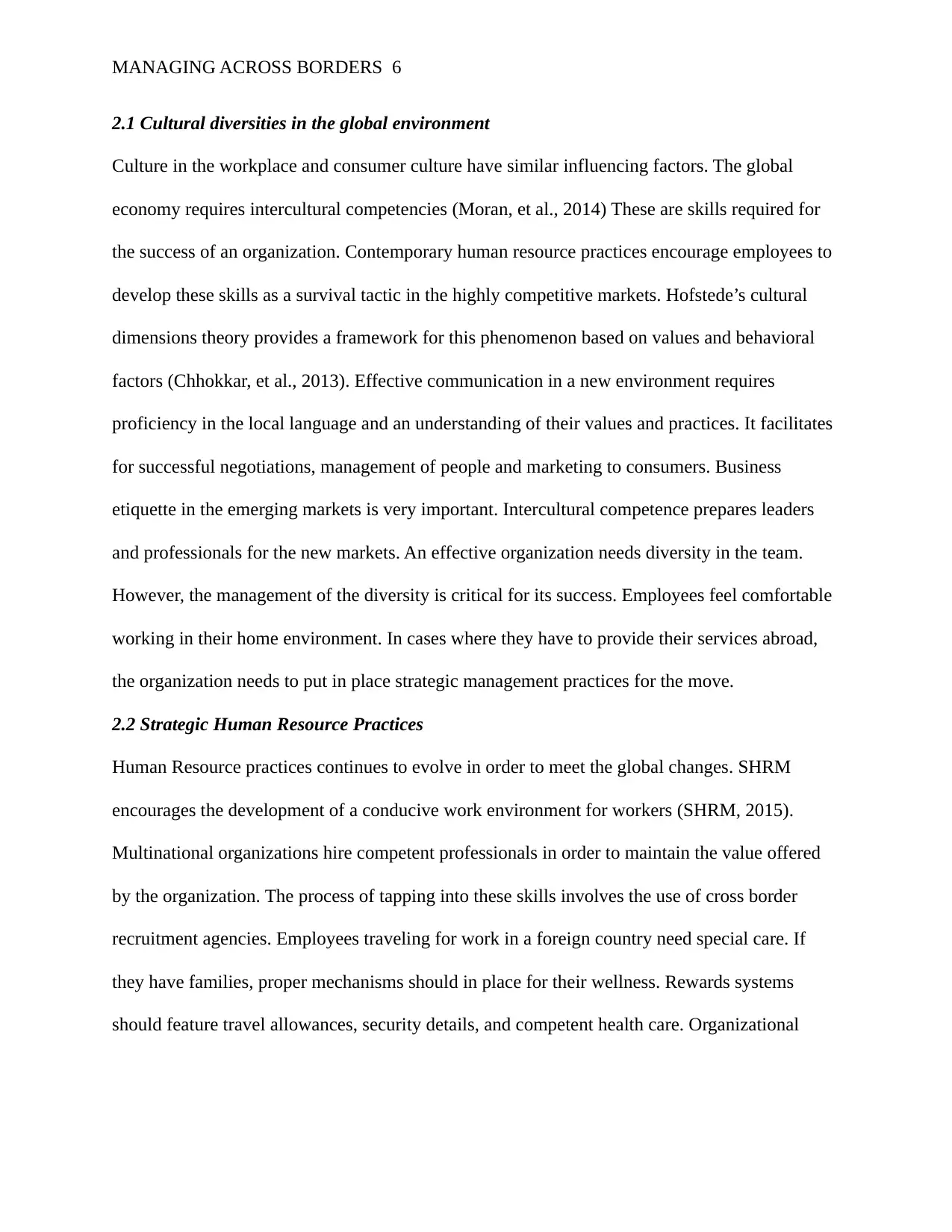
MANAGING ACROSS BORDERS 6
2.1 Cultural diversities in the global environment
Culture in the workplace and consumer culture have similar influencing factors. The global
economy requires intercultural competencies (Moran, et al., 2014) These are skills required for
the success of an organization. Contemporary human resource practices encourage employees to
develop these skills as a survival tactic in the highly competitive markets. Hofstede’s cultural
dimensions theory provides a framework for this phenomenon based on values and behavioral
factors (Chhokkar, et al., 2013). Effective communication in a new environment requires
proficiency in the local language and an understanding of their values and practices. It facilitates
for successful negotiations, management of people and marketing to consumers. Business
etiquette in the emerging markets is very important. Intercultural competence prepares leaders
and professionals for the new markets. An effective organization needs diversity in the team.
However, the management of the diversity is critical for its success. Employees feel comfortable
working in their home environment. In cases where they have to provide their services abroad,
the organization needs to put in place strategic management practices for the move.
2.2 Strategic Human Resource Practices
Human Resource practices continues to evolve in order to meet the global changes. SHRM
encourages the development of a conducive work environment for workers (SHRM, 2015).
Multinational organizations hire competent professionals in order to maintain the value offered
by the organization. The process of tapping into these skills involves the use of cross border
recruitment agencies. Employees traveling for work in a foreign country need special care. If
they have families, proper mechanisms should in place for their wellness. Rewards systems
should feature travel allowances, security details, and competent health care. Organizational
2.1 Cultural diversities in the global environment
Culture in the workplace and consumer culture have similar influencing factors. The global
economy requires intercultural competencies (Moran, et al., 2014) These are skills required for
the success of an organization. Contemporary human resource practices encourage employees to
develop these skills as a survival tactic in the highly competitive markets. Hofstede’s cultural
dimensions theory provides a framework for this phenomenon based on values and behavioral
factors (Chhokkar, et al., 2013). Effective communication in a new environment requires
proficiency in the local language and an understanding of their values and practices. It facilitates
for successful negotiations, management of people and marketing to consumers. Business
etiquette in the emerging markets is very important. Intercultural competence prepares leaders
and professionals for the new markets. An effective organization needs diversity in the team.
However, the management of the diversity is critical for its success. Employees feel comfortable
working in their home environment. In cases where they have to provide their services abroad,
the organization needs to put in place strategic management practices for the move.
2.2 Strategic Human Resource Practices
Human Resource practices continues to evolve in order to meet the global changes. SHRM
encourages the development of a conducive work environment for workers (SHRM, 2015).
Multinational organizations hire competent professionals in order to maintain the value offered
by the organization. The process of tapping into these skills involves the use of cross border
recruitment agencies. Employees traveling for work in a foreign country need special care. If
they have families, proper mechanisms should in place for their wellness. Rewards systems
should feature travel allowances, security details, and competent health care. Organizational
⊘ This is a preview!⊘
Do you want full access?
Subscribe today to unlock all pages.

Trusted by 1+ million students worldwide
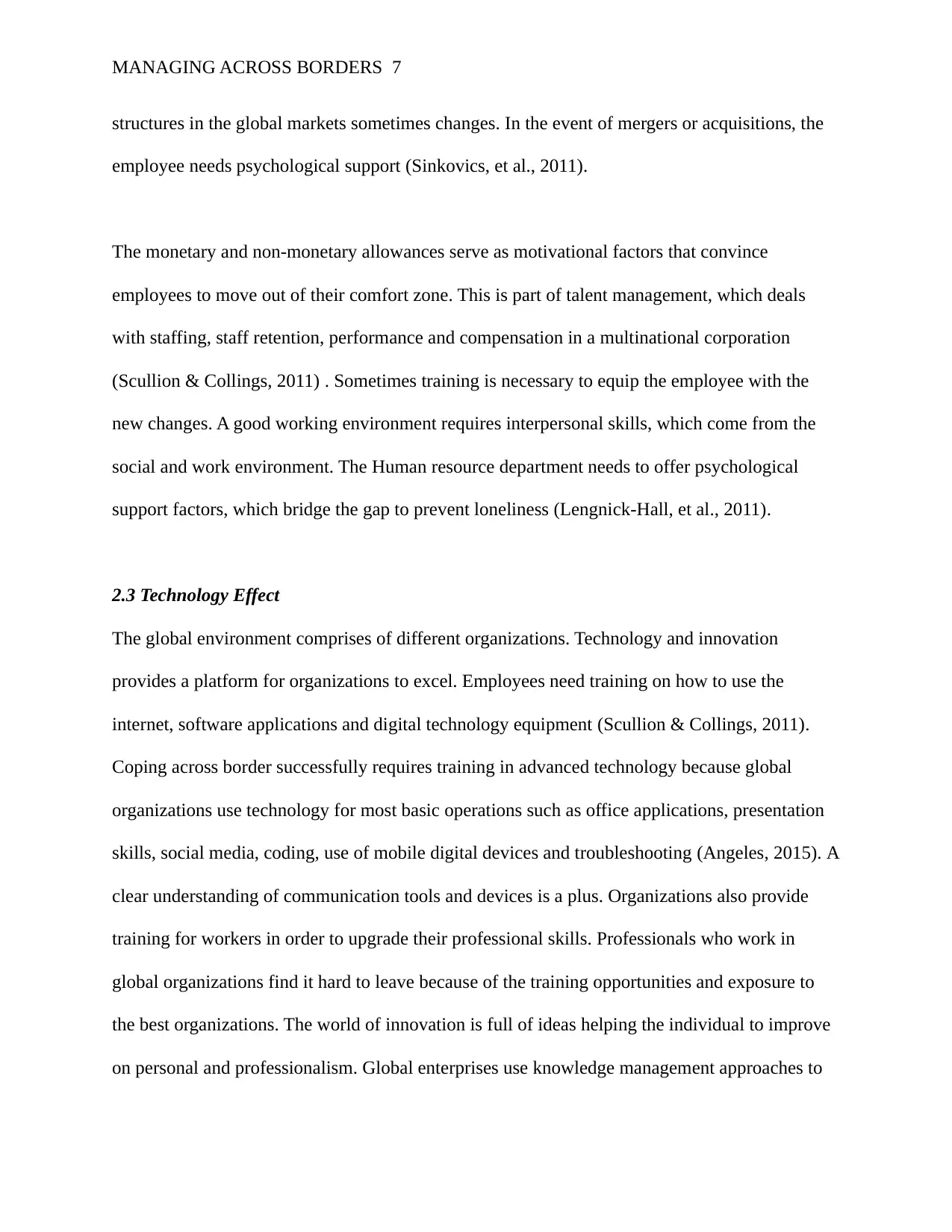
MANAGING ACROSS BORDERS 7
structures in the global markets sometimes changes. In the event of mergers or acquisitions, the
employee needs psychological support (Sinkovics, et al., 2011).
The monetary and non-monetary allowances serve as motivational factors that convince
employees to move out of their comfort zone. This is part of talent management, which deals
with staffing, staff retention, performance and compensation in a multinational corporation
(Scullion & Collings, 2011) . Sometimes training is necessary to equip the employee with the
new changes. A good working environment requires interpersonal skills, which come from the
social and work environment. The Human resource department needs to offer psychological
support factors, which bridge the gap to prevent loneliness (Lengnick-Hall, et al., 2011).
2.3 Technology Effect
The global environment comprises of different organizations. Technology and innovation
provides a platform for organizations to excel. Employees need training on how to use the
internet, software applications and digital technology equipment (Scullion & Collings, 2011).
Coping across border successfully requires training in advanced technology because global
organizations use technology for most basic operations such as office applications, presentation
skills, social media, coding, use of mobile digital devices and troubleshooting (Angeles, 2015). A
clear understanding of communication tools and devices is a plus. Organizations also provide
training for workers in order to upgrade their professional skills. Professionals who work in
global organizations find it hard to leave because of the training opportunities and exposure to
the best organizations. The world of innovation is full of ideas helping the individual to improve
on personal and professionalism. Global enterprises use knowledge management approaches to
structures in the global markets sometimes changes. In the event of mergers or acquisitions, the
employee needs psychological support (Sinkovics, et al., 2011).
The monetary and non-monetary allowances serve as motivational factors that convince
employees to move out of their comfort zone. This is part of talent management, which deals
with staffing, staff retention, performance and compensation in a multinational corporation
(Scullion & Collings, 2011) . Sometimes training is necessary to equip the employee with the
new changes. A good working environment requires interpersonal skills, which come from the
social and work environment. The Human resource department needs to offer psychological
support factors, which bridge the gap to prevent loneliness (Lengnick-Hall, et al., 2011).
2.3 Technology Effect
The global environment comprises of different organizations. Technology and innovation
provides a platform for organizations to excel. Employees need training on how to use the
internet, software applications and digital technology equipment (Scullion & Collings, 2011).
Coping across border successfully requires training in advanced technology because global
organizations use technology for most basic operations such as office applications, presentation
skills, social media, coding, use of mobile digital devices and troubleshooting (Angeles, 2015). A
clear understanding of communication tools and devices is a plus. Organizations also provide
training for workers in order to upgrade their professional skills. Professionals who work in
global organizations find it hard to leave because of the training opportunities and exposure to
the best organizations. The world of innovation is full of ideas helping the individual to improve
on personal and professionalism. Global enterprises use knowledge management approaches to
Paraphrase This Document
Need a fresh take? Get an instant paraphrase of this document with our AI Paraphraser
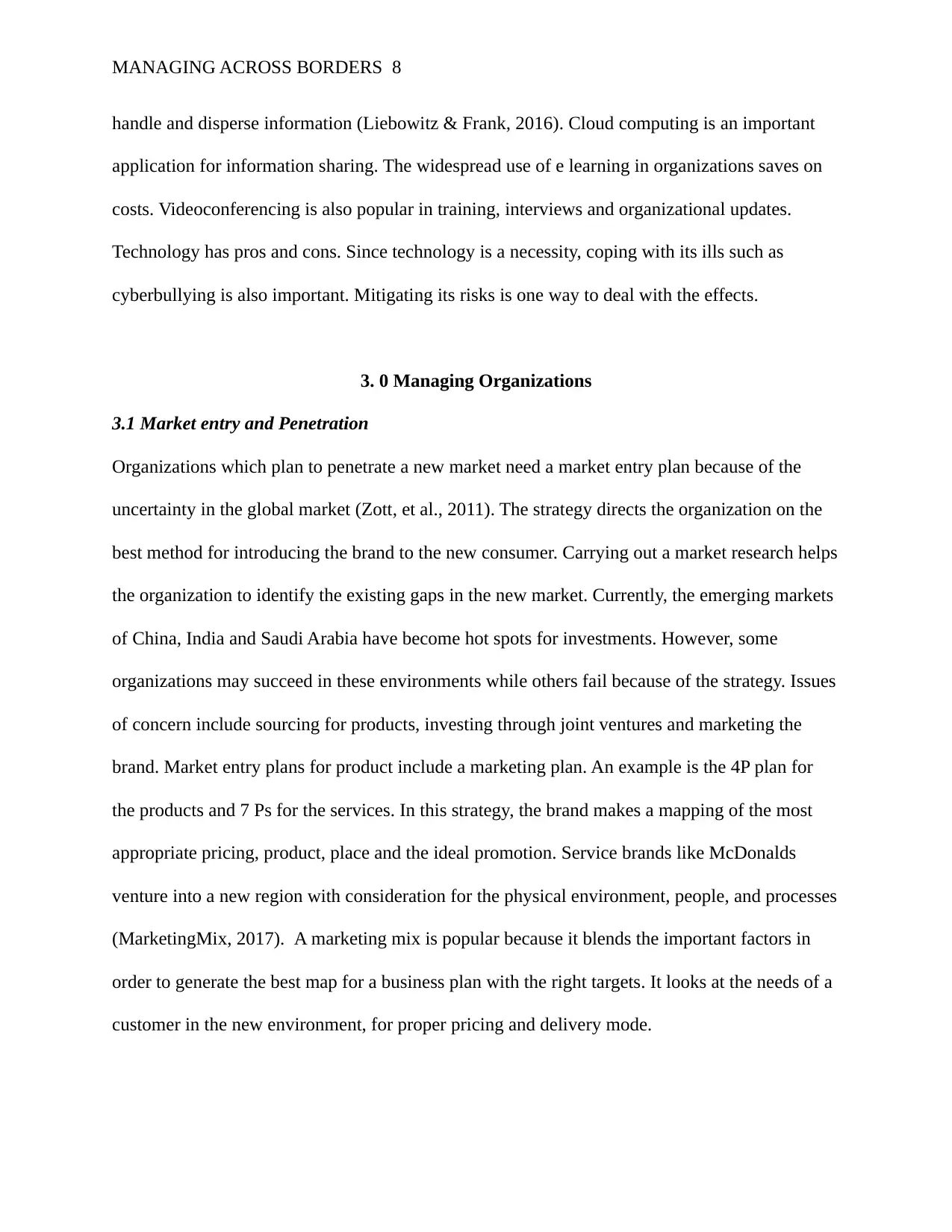
MANAGING ACROSS BORDERS 8
handle and disperse information (Liebowitz & Frank, 2016). Cloud computing is an important
application for information sharing. The widespread use of e learning in organizations saves on
costs. Videoconferencing is also popular in training, interviews and organizational updates.
Technology has pros and cons. Since technology is a necessity, coping with its ills such as
cyberbullying is also important. Mitigating its risks is one way to deal with the effects.
3. 0 Managing Organizations
3.1 Market entry and Penetration
Organizations which plan to penetrate a new market need a market entry plan because of the
uncertainty in the global market (Zott, et al., 2011). The strategy directs the organization on the
best method for introducing the brand to the new consumer. Carrying out a market research helps
the organization to identify the existing gaps in the new market. Currently, the emerging markets
of China, India and Saudi Arabia have become hot spots for investments. However, some
organizations may succeed in these environments while others fail because of the strategy. Issues
of concern include sourcing for products, investing through joint ventures and marketing the
brand. Market entry plans for product include a marketing plan. An example is the 4P plan for
the products and 7 Ps for the services. In this strategy, the brand makes a mapping of the most
appropriate pricing, product, place and the ideal promotion. Service brands like McDonalds
venture into a new region with consideration for the physical environment, people, and processes
(MarketingMix, 2017). A marketing mix is popular because it blends the important factors in
order to generate the best map for a business plan with the right targets. It looks at the needs of a
customer in the new environment, for proper pricing and delivery mode.
handle and disperse information (Liebowitz & Frank, 2016). Cloud computing is an important
application for information sharing. The widespread use of e learning in organizations saves on
costs. Videoconferencing is also popular in training, interviews and organizational updates.
Technology has pros and cons. Since technology is a necessity, coping with its ills such as
cyberbullying is also important. Mitigating its risks is one way to deal with the effects.
3. 0 Managing Organizations
3.1 Market entry and Penetration
Organizations which plan to penetrate a new market need a market entry plan because of the
uncertainty in the global market (Zott, et al., 2011). The strategy directs the organization on the
best method for introducing the brand to the new consumer. Carrying out a market research helps
the organization to identify the existing gaps in the new market. Currently, the emerging markets
of China, India and Saudi Arabia have become hot spots for investments. However, some
organizations may succeed in these environments while others fail because of the strategy. Issues
of concern include sourcing for products, investing through joint ventures and marketing the
brand. Market entry plans for product include a marketing plan. An example is the 4P plan for
the products and 7 Ps for the services. In this strategy, the brand makes a mapping of the most
appropriate pricing, product, place and the ideal promotion. Service brands like McDonalds
venture into a new region with consideration for the physical environment, people, and processes
(MarketingMix, 2017). A marketing mix is popular because it blends the important factors in
order to generate the best map for a business plan with the right targets. It looks at the needs of a
customer in the new environment, for proper pricing and delivery mode.
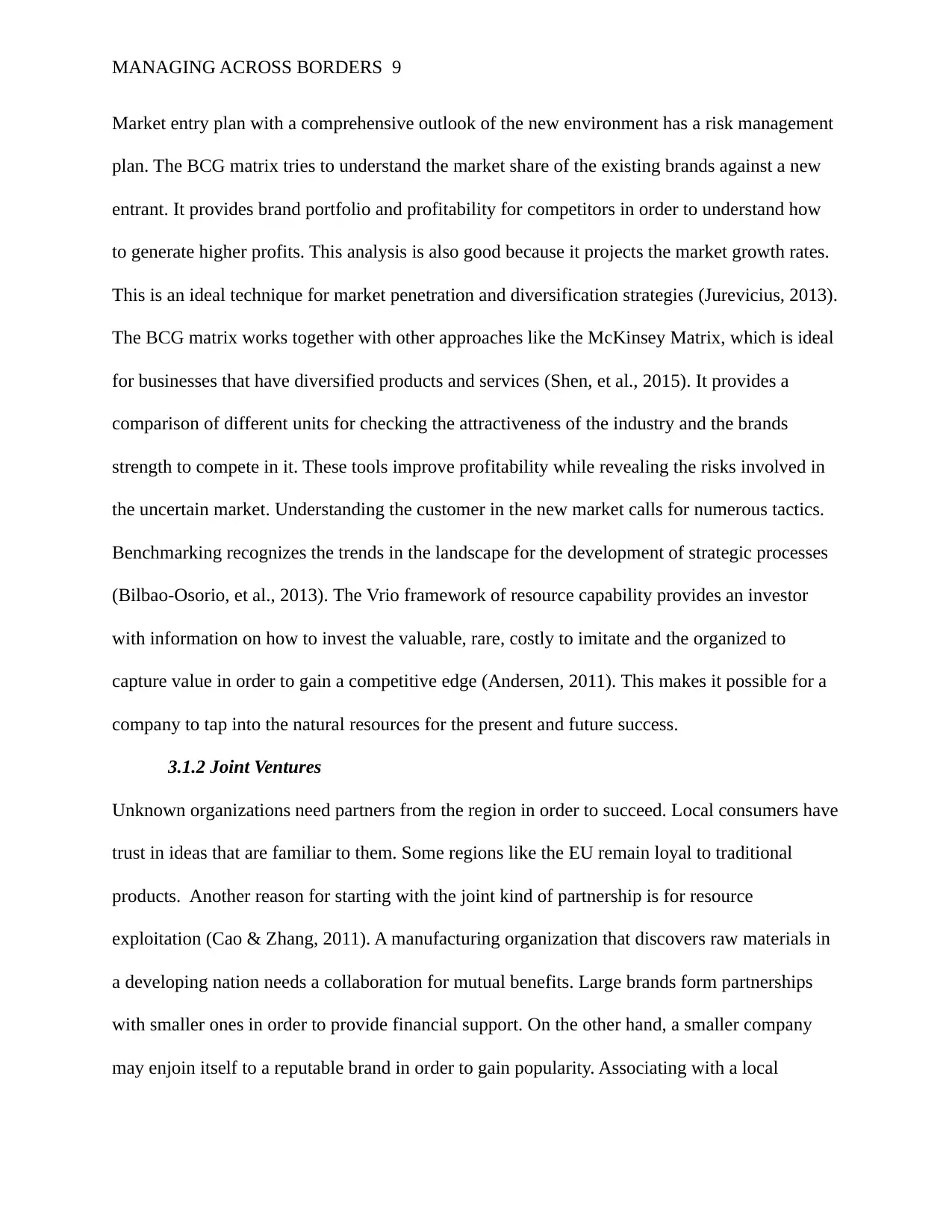
MANAGING ACROSS BORDERS 9
Market entry plan with a comprehensive outlook of the new environment has a risk management
plan. The BCG matrix tries to understand the market share of the existing brands against a new
entrant. It provides brand portfolio and profitability for competitors in order to understand how
to generate higher profits. This analysis is also good because it projects the market growth rates.
This is an ideal technique for market penetration and diversification strategies (Jurevicius, 2013).
The BCG matrix works together with other approaches like the McKinsey Matrix, which is ideal
for businesses that have diversified products and services (Shen, et al., 2015). It provides a
comparison of different units for checking the attractiveness of the industry and the brands
strength to compete in it. These tools improve profitability while revealing the risks involved in
the uncertain market. Understanding the customer in the new market calls for numerous tactics.
Benchmarking recognizes the trends in the landscape for the development of strategic processes
(Bilbao-Osorio, et al., 2013). The Vrio framework of resource capability provides an investor
with information on how to invest the valuable, rare, costly to imitate and the organized to
capture value in order to gain a competitive edge (Andersen, 2011). This makes it possible for a
company to tap into the natural resources for the present and future success.
3.1.2 Joint Ventures
Unknown organizations need partners from the region in order to succeed. Local consumers have
trust in ideas that are familiar to them. Some regions like the EU remain loyal to traditional
products. Another reason for starting with the joint kind of partnership is for resource
exploitation (Cao & Zhang, 2011). A manufacturing organization that discovers raw materials in
a developing nation needs a collaboration for mutual benefits. Large brands form partnerships
with smaller ones in order to provide financial support. On the other hand, a smaller company
may enjoin itself to a reputable brand in order to gain popularity. Associating with a local
Market entry plan with a comprehensive outlook of the new environment has a risk management
plan. The BCG matrix tries to understand the market share of the existing brands against a new
entrant. It provides brand portfolio and profitability for competitors in order to understand how
to generate higher profits. This analysis is also good because it projects the market growth rates.
This is an ideal technique for market penetration and diversification strategies (Jurevicius, 2013).
The BCG matrix works together with other approaches like the McKinsey Matrix, which is ideal
for businesses that have diversified products and services (Shen, et al., 2015). It provides a
comparison of different units for checking the attractiveness of the industry and the brands
strength to compete in it. These tools improve profitability while revealing the risks involved in
the uncertain market. Understanding the customer in the new market calls for numerous tactics.
Benchmarking recognizes the trends in the landscape for the development of strategic processes
(Bilbao-Osorio, et al., 2013). The Vrio framework of resource capability provides an investor
with information on how to invest the valuable, rare, costly to imitate and the organized to
capture value in order to gain a competitive edge (Andersen, 2011). This makes it possible for a
company to tap into the natural resources for the present and future success.
3.1.2 Joint Ventures
Unknown organizations need partners from the region in order to succeed. Local consumers have
trust in ideas that are familiar to them. Some regions like the EU remain loyal to traditional
products. Another reason for starting with the joint kind of partnership is for resource
exploitation (Cao & Zhang, 2011). A manufacturing organization that discovers raw materials in
a developing nation needs a collaboration for mutual benefits. Large brands form partnerships
with smaller ones in order to provide financial support. On the other hand, a smaller company
may enjoin itself to a reputable brand in order to gain popularity. Associating with a local
⊘ This is a preview!⊘
Do you want full access?
Subscribe today to unlock all pages.

Trusted by 1+ million students worldwide
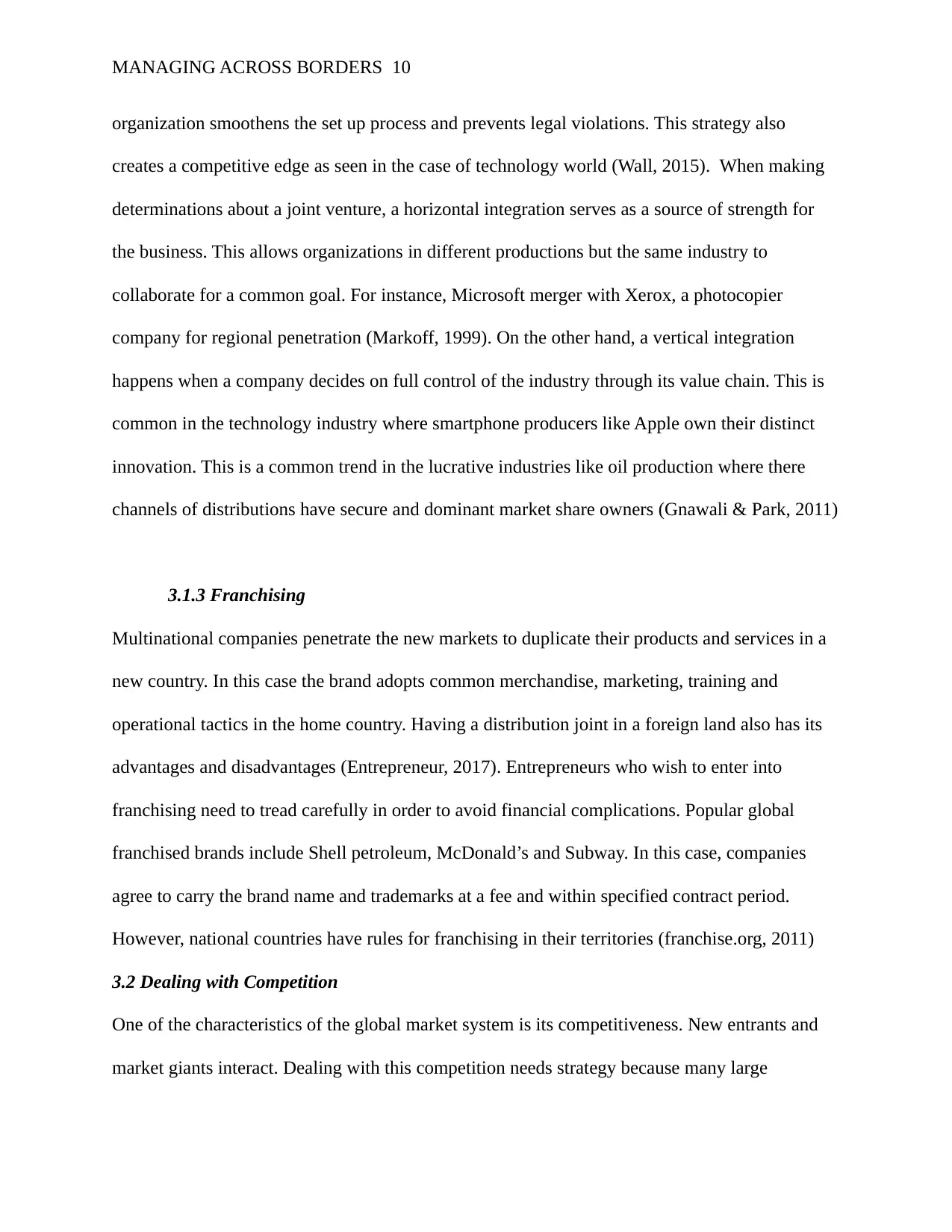
MANAGING ACROSS BORDERS 10
organization smoothens the set up process and prevents legal violations. This strategy also
creates a competitive edge as seen in the case of technology world (Wall, 2015). When making
determinations about a joint venture, a horizontal integration serves as a source of strength for
the business. This allows organizations in different productions but the same industry to
collaborate for a common goal. For instance, Microsoft merger with Xerox, a photocopier
company for regional penetration (Markoff, 1999). On the other hand, a vertical integration
happens when a company decides on full control of the industry through its value chain. This is
common in the technology industry where smartphone producers like Apple own their distinct
innovation. This is a common trend in the lucrative industries like oil production where there
channels of distributions have secure and dominant market share owners (Gnawali & Park, 2011)
3.1.3 Franchising
Multinational companies penetrate the new markets to duplicate their products and services in a
new country. In this case the brand adopts common merchandise, marketing, training and
operational tactics in the home country. Having a distribution joint in a foreign land also has its
advantages and disadvantages (Entrepreneur, 2017). Entrepreneurs who wish to enter into
franchising need to tread carefully in order to avoid financial complications. Popular global
franchised brands include Shell petroleum, McDonald’s and Subway. In this case, companies
agree to carry the brand name and trademarks at a fee and within specified contract period.
However, national countries have rules for franchising in their territories (franchise.org, 2011)
3.2 Dealing with Competition
One of the characteristics of the global market system is its competitiveness. New entrants and
market giants interact. Dealing with this competition needs strategy because many large
organization smoothens the set up process and prevents legal violations. This strategy also
creates a competitive edge as seen in the case of technology world (Wall, 2015). When making
determinations about a joint venture, a horizontal integration serves as a source of strength for
the business. This allows organizations in different productions but the same industry to
collaborate for a common goal. For instance, Microsoft merger with Xerox, a photocopier
company for regional penetration (Markoff, 1999). On the other hand, a vertical integration
happens when a company decides on full control of the industry through its value chain. This is
common in the technology industry where smartphone producers like Apple own their distinct
innovation. This is a common trend in the lucrative industries like oil production where there
channels of distributions have secure and dominant market share owners (Gnawali & Park, 2011)
3.1.3 Franchising
Multinational companies penetrate the new markets to duplicate their products and services in a
new country. In this case the brand adopts common merchandise, marketing, training and
operational tactics in the home country. Having a distribution joint in a foreign land also has its
advantages and disadvantages (Entrepreneur, 2017). Entrepreneurs who wish to enter into
franchising need to tread carefully in order to avoid financial complications. Popular global
franchised brands include Shell petroleum, McDonald’s and Subway. In this case, companies
agree to carry the brand name and trademarks at a fee and within specified contract period.
However, national countries have rules for franchising in their territories (franchise.org, 2011)
3.2 Dealing with Competition
One of the characteristics of the global market system is its competitiveness. New entrants and
market giants interact. Dealing with this competition needs strategy because many large
Paraphrase This Document
Need a fresh take? Get an instant paraphrase of this document with our AI Paraphraser
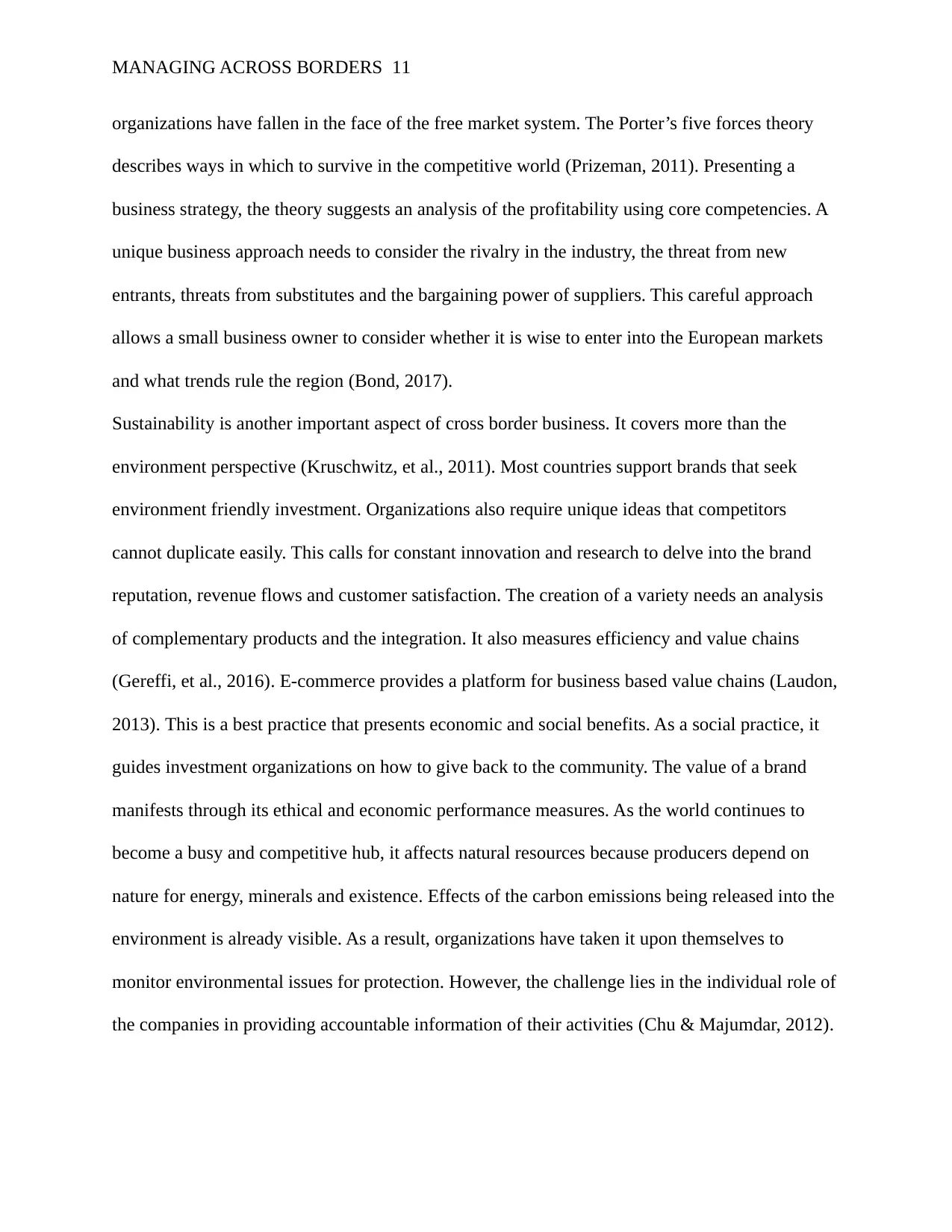
MANAGING ACROSS BORDERS 11
organizations have fallen in the face of the free market system. The Porter’s five forces theory
describes ways in which to survive in the competitive world (Prizeman, 2011). Presenting a
business strategy, the theory suggests an analysis of the profitability using core competencies. A
unique business approach needs to consider the rivalry in the industry, the threat from new
entrants, threats from substitutes and the bargaining power of suppliers. This careful approach
allows a small business owner to consider whether it is wise to enter into the European markets
and what trends rule the region (Bond, 2017).
Sustainability is another important aspect of cross border business. It covers more than the
environment perspective (Kruschwitz, et al., 2011). Most countries support brands that seek
environment friendly investment. Organizations also require unique ideas that competitors
cannot duplicate easily. This calls for constant innovation and research to delve into the brand
reputation, revenue flows and customer satisfaction. The creation of a variety needs an analysis
of complementary products and the integration. It also measures efficiency and value chains
(Gereffi, et al., 2016). E-commerce provides a platform for business based value chains (Laudon,
2013). This is a best practice that presents economic and social benefits. As a social practice, it
guides investment organizations on how to give back to the community. The value of a brand
manifests through its ethical and economic performance measures. As the world continues to
become a busy and competitive hub, it affects natural resources because producers depend on
nature for energy, minerals and existence. Effects of the carbon emissions being released into the
environment is already visible. As a result, organizations have taken it upon themselves to
monitor environmental issues for protection. However, the challenge lies in the individual role of
the companies in providing accountable information of their activities (Chu & Majumdar, 2012).
organizations have fallen in the face of the free market system. The Porter’s five forces theory
describes ways in which to survive in the competitive world (Prizeman, 2011). Presenting a
business strategy, the theory suggests an analysis of the profitability using core competencies. A
unique business approach needs to consider the rivalry in the industry, the threat from new
entrants, threats from substitutes and the bargaining power of suppliers. This careful approach
allows a small business owner to consider whether it is wise to enter into the European markets
and what trends rule the region (Bond, 2017).
Sustainability is another important aspect of cross border business. It covers more than the
environment perspective (Kruschwitz, et al., 2011). Most countries support brands that seek
environment friendly investment. Organizations also require unique ideas that competitors
cannot duplicate easily. This calls for constant innovation and research to delve into the brand
reputation, revenue flows and customer satisfaction. The creation of a variety needs an analysis
of complementary products and the integration. It also measures efficiency and value chains
(Gereffi, et al., 2016). E-commerce provides a platform for business based value chains (Laudon,
2013). This is a best practice that presents economic and social benefits. As a social practice, it
guides investment organizations on how to give back to the community. The value of a brand
manifests through its ethical and economic performance measures. As the world continues to
become a busy and competitive hub, it affects natural resources because producers depend on
nature for energy, minerals and existence. Effects of the carbon emissions being released into the
environment is already visible. As a result, organizations have taken it upon themselves to
monitor environmental issues for protection. However, the challenge lies in the individual role of
the companies in providing accountable information of their activities (Chu & Majumdar, 2012).
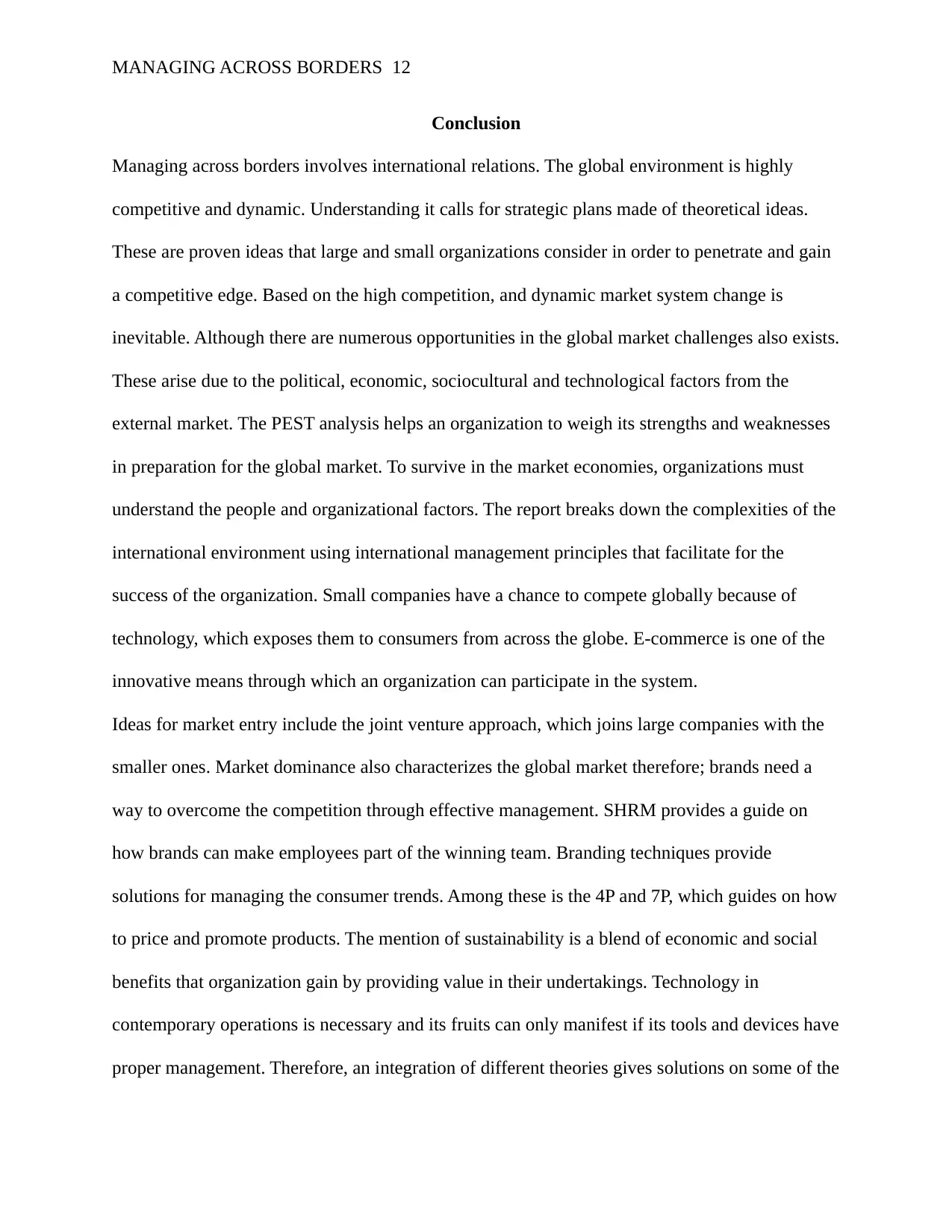
MANAGING ACROSS BORDERS 12
Conclusion
Managing across borders involves international relations. The global environment is highly
competitive and dynamic. Understanding it calls for strategic plans made of theoretical ideas.
These are proven ideas that large and small organizations consider in order to penetrate and gain
a competitive edge. Based on the high competition, and dynamic market system change is
inevitable. Although there are numerous opportunities in the global market challenges also exists.
These arise due to the political, economic, sociocultural and technological factors from the
external market. The PEST analysis helps an organization to weigh its strengths and weaknesses
in preparation for the global market. To survive in the market economies, organizations must
understand the people and organizational factors. The report breaks down the complexities of the
international environment using international management principles that facilitate for the
success of the organization. Small companies have a chance to compete globally because of
technology, which exposes them to consumers from across the globe. E-commerce is one of the
innovative means through which an organization can participate in the system.
Ideas for market entry include the joint venture approach, which joins large companies with the
smaller ones. Market dominance also characterizes the global market therefore; brands need a
way to overcome the competition through effective management. SHRM provides a guide on
how brands can make employees part of the winning team. Branding techniques provide
solutions for managing the consumer trends. Among these is the 4P and 7P, which guides on how
to price and promote products. The mention of sustainability is a blend of economic and social
benefits that organization gain by providing value in their undertakings. Technology in
contemporary operations is necessary and its fruits can only manifest if its tools and devices have
proper management. Therefore, an integration of different theories gives solutions on some of the
Conclusion
Managing across borders involves international relations. The global environment is highly
competitive and dynamic. Understanding it calls for strategic plans made of theoretical ideas.
These are proven ideas that large and small organizations consider in order to penetrate and gain
a competitive edge. Based on the high competition, and dynamic market system change is
inevitable. Although there are numerous opportunities in the global market challenges also exists.
These arise due to the political, economic, sociocultural and technological factors from the
external market. The PEST analysis helps an organization to weigh its strengths and weaknesses
in preparation for the global market. To survive in the market economies, organizations must
understand the people and organizational factors. The report breaks down the complexities of the
international environment using international management principles that facilitate for the
success of the organization. Small companies have a chance to compete globally because of
technology, which exposes them to consumers from across the globe. E-commerce is one of the
innovative means through which an organization can participate in the system.
Ideas for market entry include the joint venture approach, which joins large companies with the
smaller ones. Market dominance also characterizes the global market therefore; brands need a
way to overcome the competition through effective management. SHRM provides a guide on
how brands can make employees part of the winning team. Branding techniques provide
solutions for managing the consumer trends. Among these is the 4P and 7P, which guides on how
to price and promote products. The mention of sustainability is a blend of economic and social
benefits that organization gain by providing value in their undertakings. Technology in
contemporary operations is necessary and its fruits can only manifest if its tools and devices have
proper management. Therefore, an integration of different theories gives solutions on some of the
⊘ This is a preview!⊘
Do you want full access?
Subscribe today to unlock all pages.

Trusted by 1+ million students worldwide
1 out of 16
Related Documents
Your All-in-One AI-Powered Toolkit for Academic Success.
+13062052269
info@desklib.com
Available 24*7 on WhatsApp / Email
![[object Object]](/_next/static/media/star-bottom.7253800d.svg)
Unlock your academic potential
Copyright © 2020–2025 A2Z Services. All Rights Reserved. Developed and managed by ZUCOL.





